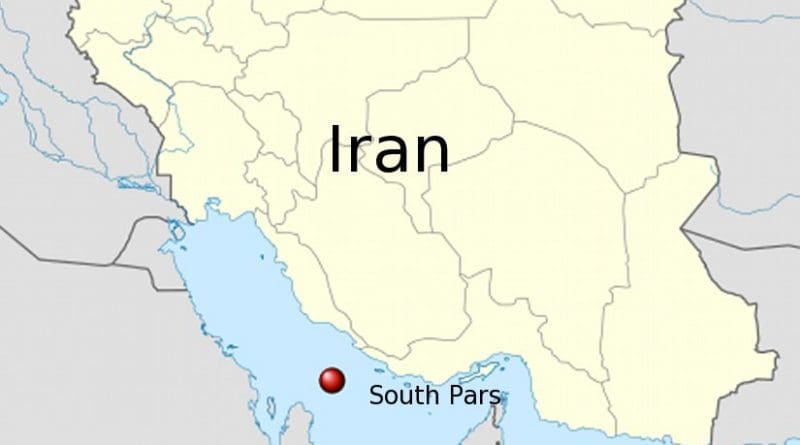South Pars Gas Field: Achieving Balance In Gas Production – OpEd
By Iran Review
By Ali Asghar Zargar*
The South Pars Gas Field is a natural gas field located in the Persian Gulf. It is the world’s largest gas field, shared between the Islamic Republic of Iran and Qatar. The two countries’ common border, which was agreed upon in 1968, has divided the field between the two sides.
According to the International Energy Agency (IEA), the field possesses an estimated 51 trillion cubic meters of natural gas and about 7.9 billion barrels of condensate. In comparison to other natural gas fields, it has more recoverable reserves than all other fields combined. This gas field covers an area of 9,700 square kilometers of which 3,700 square kilometers, which is known as the South Pars Gas Field, is located in Iran’s territorial waters, while 6,000 square kilometers, known as the North Dome, is situated in Qatar’s territorial waters.
The Iranian section of the field is considered the most significant source of energy for the country. The gas reserves of this huge field account for about 8 percent of the world’s total gas reserves. The Iranian section of the field accounts for almost half of the country’s domestic gas reserves.
Iranian President Hassan Rouhani inaugurated eight development projects of South Pars Gas Field about three weeks ago. During his visit, Rouhani inaugurated 20-billion-dollar worth of projects concerning five phases of the field, including phases 17, 18, 19, 20 and 21. It should be noted that at the present time, Iran is scheduled to develop 28 blocks of the field, divided into 24 phases, to produce 790 million cubic meters of gas per day. South Pars Gas Field was originally developed for such purposes as meeting increasing domestic demand for natural gas, injecting gas into oil fields, exporting gas, and production of LNG and liquefied gas to feed the country’s petrochemical plants. Assaluyeh and Kangan, located respectively 270 km and 220 km southeast of Bushehr port city, have been selected as the coastal regions for the implementation of the aforesaid projects.
Inauguration of the aforementioned phases of the gas field, which are expected to become operational in the near future, will boost production from the Iranian side of the field and enable Iran to balance its gas output from the joint field with Qatar or even exceed Qatar’s production level. This will effectively put an end to two decades of production gap between Iran and Qatar. In fact, even now, Iran’s production from the field has reached 575 million cubic meters per day.
In the light of the above facts, the main questions are whether further development of the field will continue; whether Iran’s technical and technological capabilities would be able to support future development of the field in cooperation with foreign firms in the form of joint ventures; and finally, in case of further development, how Qatar would react to Iran’s increased production from the field?
Iran has proved that it possesses relatively adequate technological and technical capabilities – if needed through procurement of required equipment and materials from abroad – to develop different phases of the gas field, though with some delay. Petro Pars Company, a general contractor affiliated to the National Iranian Oil Company, is an Iranian company in charge of developing certain phases of the field. It has so far developed 11 blocks out of 28 blocks of the field through five projects. Another Iranian contractor, Khatam-al Anbiya Construction Headquarters, which is affiliated with the Islamic Revolution Guards Corps (IRGC), also enjoys enough capabilities and experience to work independently or in cooperation with other companies to develop the field in Assaluyeh and Kangan regions, which are coastal regions chosen for establishment of onshore facilities related to the aforesaid projects.
With regard to foreign investment in the field, it must be noted that following conclusion of Iran’s nuclear deal with six world powers, known as the Joint Comprehensive Plan of Action (JCPOA), foreign companies have offered a number of investment proposals. In November 2016, France’s Total signed a preliminary accord worth an estimated 4.5 billion euros to help with development of a South Pars phase on a 50% basis. The company, however, noted that it would wait for signals from Washington before finalizing the deal.
Of course, further development of the field may be hampered by prolongation of low gas prices, which are expected to continue into the near future and have had varied impacts on both countries. Low gas prices may prompt both countries to develop value-added industries, which are based on natural gas, and export gas to neighboring countries through pipeline. Qatar may also find its huge investment in liquefied natural gas (LNG) much less profitable than the past and, similar to Iran, may have to turn to exporting gas to neighboring countries through pipeline while boosting production of value-added products from natural gas.
If Iran is to expand investment in South Pars Gas Field, it must pay attention to Qatar’s experience in this regard as well as challenges it may face for boosting LNG production before pursuing a similar path. LNG production requires large investment and access to advanced technology, which is only available from a limited number of Western and American companies, and Iran has yet to get access to that technology.
Another issue, which may be the most important issue with respect to exploitation of this joint gas field, is the need for Iran to have good neighborly relations with the member states of the [Persian] Gulf Cooperation Council. Stability of the region and the gas field is in the best interest of all regional countries and the rest of the world. Therefore, they must encourage both Iran and Qatar to have cordial relations and manage the field in a responsible manner. As such, continued military buildup in the region and adopting a hardline security-focused approach could trigger conflict, which would not be in the interest of either party.
* Ali Asghar Zargar, Energy Expert

